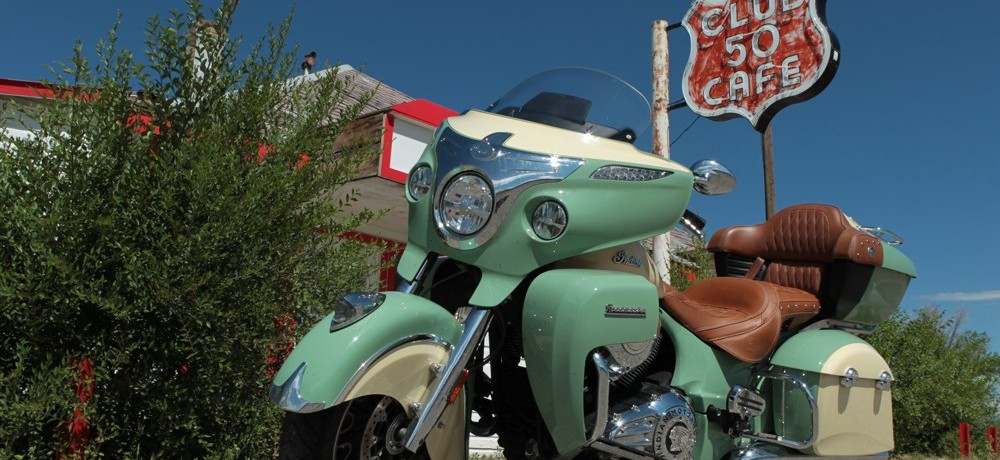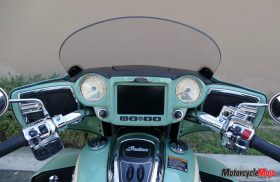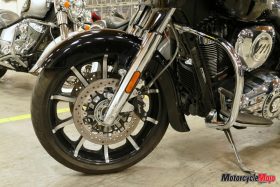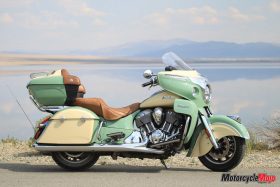Indian’s luxury tourer not only delivers comfort and performance, but draws quite a crowd, too
“Is that your gorgeous cruiser out there?” She’s drawn out the word “gorgeous” like warm butter across fresh bread, then accentuates it with a darting eye roll. I’m five-deep in a torturously slow grocery line at the Albertson’s in Missoula, Montana. Glancing outside I can see the devilishly hot sun winking off the Indian Roadmaster’s nostalgic green-and-cream fairing. The bike is drawing yet another small crowd. I’m not sure an ice cream truck would please as many people.
“Yup,” I say sheepishly, wondering if my Gatorade, apple and Snickers bar are worth waiting in the long grocery line. “Well, it’s not exactly mine.” I admit. “I’m just testing it out. It belongs to Indian.” I know this answer is going to solicit further questioning, but the cashier has called for another price check, and talking about the Roadmaster and the resurrection of Indian Motorcycles is way more fun than staring at a rack of tabloids touting alien invasions and potentially pregnant celebs.
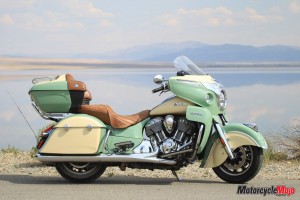
In 2011, nearly 60 years after the last authentic Indian rolled off the line in Springfield, Massachusetts, manufacturing giant Polaris Industries, known for its engineering prowess, heartland values and enthusiast workforce, was able to buy and breathe real life into the brand. By the 2014 model year, there were three all-new renditions of the much-romanticized Chief on the road: the Classic, the Vintage and the first Chieftain with its fork-mounted fairing and hard bags. In 2015, the luxury-touring Roadmaster was added to the list of players, offering riders a spacious hard-shell trunk, fairing lowers, an electronically adjustable windshield, extensive stereo/infotainment system, and heated grips and seats for both rider and passenger.
The Heart of the Matter
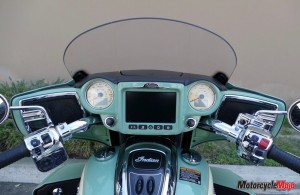
Around town, the Roadmaster’s power output is beyond ample, and plenty for legal highway and interstate speeds, too. By the time I was locked in the conversation in the Albertson’s grocery line, I’d already put 4,500 km on the Roadmaster, travelling through Southern California, Nevada, Idaho and Montana almost entirely on two-lane highways. So yes, there had been lots and lots of passing tourists in their RVs and rental cars. The Roadmaster makes short work of it, though it typically asks to be kicked down a gear.
Not only did Polaris engineers invest a ton of time and energy in creating a showpiece engine that is as pleasing to look at as it is to throttle around, they went to great pains to develop an exhaust pulse that would sound – and feel – amazing. The transmission and gear pairs were designed from the get-go to give off very low mechanical noise so one hears as pure an engine pulse as possible. On or off the bike, people love the way the Thunder Stroke sounds at idle, both in cadence and in tone.
It’s also intentional that the rider feels that pulse via a mostly pleasant drumbeat rising through the seat, floorboards and handlebar. For me, the sweet spot is 2,000 rpm in the higher gears, where a light, rolling throb reminds me it’s a great day. However, around 2,600 rpm (113 km/h in sixth gear), there is a less-pleasant surge of high-frequency vibration that tickles the feet and tires the hands, but it’s specific, and mostly avoidable with a shift in gear or change of speed.
Indian Summer

And I had been riding through about as hot of weather as you can imagine. In Nevada, temperatures held between 44 and 46 C for an entire afternoon that found me buying armloads of Popsicles at each gas stop – not to eat, but to situate in my riding clothes. The Roadmaster provides vents in each fairing lower to allow for airflow, and the lowers can be easily removed (three bolts apiece) if you were planning ahead for a hot ride.
Accessory highway pegs would have been a godsend for this hot-weather tour, but only to increase airflow. The Roadmaster’s ergonomics and seat are incredibly comfortable, even for the 12-hour days I was putting in. The floorboards are spacious and keep the hips and knees at neutral angles, while the wide handlebar is restful for the shoulders. And those flashy leather seats? Every bit as comfortable as they are beautiful. At the time of this writing, I am now 12 days and 6,000 km into a lap of the U.S., and the only parts complaining are my hands: a soreness I attribute to a combination of the Roadmaster’s long, somewhat-heavy clutch pull, firm throttle and light vibration that creates fatigue over many days.
That said, my favourite gadget on the amenity-laden bike is the cruise-control feature. So easy to rest the hands with a simple pop of auto-throttle,
though the switch housings on the 2017 model I’ve been riding are so wide, engaging the cruise requires a quick reach across with the left hand. The good news for buyers is that Indian has remedied this oft-lamented design flaw by creating narrower switch casings for the 2018 model.
Not-So-Tiny Dancer
Despite the Roadmaster’s 421 kg wet weight, it feels quite lithe underway. Sure, there are some tippy moments that require concentration in parking lots, especially when you’re toting a load and/or passenger, but as soon as you power away, the weight is gathered and the bike becomes exceptionally controllable. Both the Chieftain and the Roadmaster enjoy a steeper rake than the base model Chiefs (25 degrees compared with 29 degrees), resulting in a shorter wheelbase and lower bar height. This steering geometry, coupled with an air-adjustable mono shock, makes the touring models feel more nimble at low speeds. They also require less effort in aggressive cornering, despite their heavier weight.
Its brakes are strong and the bike comes standard with ABS that is separated for the front and rear wheels, unlike similar Harley-Davidson units and other heavy cruisers, which link the ABS. Ground clearance is very impressive. I’ve spent a good portion of my high-mileage test diving into corners along the most famous back roads of the American West and find it a challenge to scrape the floorboards. Additionally, there was only one time I clanked a hard part (the floorboard mounting bracket), and that was while riding two up on an extremely lumpy road.
Tourer with All the Trimmings
I had occasion to carry a passenger over two days, and she described the pillion accommodations as lovely. She was entirely comfortable for long stints and felt secure, thanks to the padded leather backrest and its arm buds, but did note she would want to add the optional armrest pads for extra comfort. We both wished the stereo system sounded clearer above cruise-night speeds. The only way to really enjoy great music would be to use a Bluetooth helmet. The bike’s Ride Command infotainment system is Bluetooth capable and syncs with your smartphone in seconds.
The infotainment system’s large screen is easy to navigate, even with gloved fingers. It displays a wealth of information about the bike’s status, including real-time tire pressures, which I found extremely helpful as I limped into British Columbia with a leaky rear tire. It turned out to be a tiny bur on the rim, which Indian Motorcycles of Langley, B.C., quickly sorted out so that I was back on the road in a jiff. Such great service and super-friendly people at that Polaris dealership.
The Roadmaster’s navigation program is useful for general directions, but not nearly as smart as my smartphone, so I often ended up getting voice-only directions from my phone, which was connected to the bike so I could listen to the directions over the speaker system. For 2018, the bike receives an updated GPS program, which will hopefully abolish the misguides and lack of data regarding specific destinations.
People along the way were constantly asking about the huge infotainment screen. “Is that a computer?” they’d ask in awe. It really is a large screen and seems a little out of place paired with the bike’s super-nostalgic mechanical gauges and general retro vibe, but all the modern niceties pay off when you’re travelling, especially the push-button height-adjustable windscreen. The keyless fob is another bonus, which lets you lock the roomy trunk and saddlebags remotely. I haven’t had much call for the heated seats and grips, but they appear to work perfectly well.
Of course, all this luxury, glamour and convenience adds up at the cash register. A Roadmaster in basic Thunder Black starts at $35,299, with two-tone colours adding an instant $1,400. Filling up will likewise be costly, as the bike asks for 91-octane fuel and delivers an average 7.8 L/100 km. But then, the target buyer is no cheapskate. Indian’s tag line for this model is “Dues Paid, Reward Earned,” positioning the bike as a pat-on-the-back for those perched comfortably atop their ladders.
Belle of the Ball
By the time I finish telling the tale to the smitten woman and her husband in line at the grocery store in Missoula, they are even more interested in the Roadmaster, and so follow me out to the parking lot to join the bike’s latest assembly of admirers. If I had a dime for every compliment I’ve received, I’d be rolling in Gatorade and Snickers for the rest of the tour. The only bike that might draw even more attention is Indian’s Classic version of the Roadmaster, with its yards of premium leather tidily stitched to swaddle the trunk and saddlebags ($32,499); or the Elite version, with its urban-swank finishes that include 23-karat gold leaf badging ($44,499).
Hastily, I snick open the trunk and pop my hard-won snacks and water inside. Nourishment will have to wait. Amid the oohs and aahs, I dawn my helmet and gloves in preparation for escape. Because the only thing more fun than basking in this Indian’s limelight is throttling it across the continent in search of the next stage.









